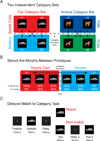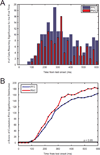Comparison of primate prefrontal and premotor cortex neuronal activity during visual categorization
- PMID: 21452948
- PMCID: PMC4741377
- DOI: 10.1162/jocn_a_00032
Comparison of primate prefrontal and premotor cortex neuronal activity during visual categorization
Abstract
Previous work has shown that neurons in the PFC show selectivity for learned categorical groupings. In contrast, brain regions lower in the visual hierarchy, such as inferior temporal cortex, do not seem to favor category information over information about physical appearance. However, the role of premotor cortex (PMC) in categorization has not been studied, despite evidence that PMC is strongly engaged by well-learned tasks and reflects learned rules. Here, we directly compare PFC neurons with PMC neurons during visual categorization. Unlike PFC neurons, relatively few PMC neurons distinguished between categories of visual images during a delayed match-to-category task. However, despite the lack of category information in the PMC, more than half of the neurons in both PFC and PMC reflected whether the category of a test image did or did not match the category of a sample image (i.e., had match information). Thus, PFC neurons represented all variables required to solve the cognitive problem, whereas PMC neurons instead represented only the final decision variable that drove the appropriate motor action required to obtain a reward. This dichotomy fits well with PFC's hypothesized role in learning arbitrary information and directing behavior as well as the PMC's role in motor planning.
Figures








References
-
- Beymer D, Poggio T. Image representations for visual learning. Science. 1996;272(5270):1905–1909. - PubMed
-
- Bolte S, Holtmann M, Poustka F, Scheurich A, Schmidt L. Gestalt perception and local-global processing in high-functioning autism. J Autism Dev Disord. 2007;37(8):1493–1504. - PubMed
-
- Buschman TJ, Miller EK. Top-down versus bottom-up control of attention in the prefrontal and posterior parietal cortices. Science. 2007;315(5820):1860–1862. - PubMed
Publication types
MeSH terms
Grants and funding
LinkOut - more resources
Full Text Sources
Miscellaneous

